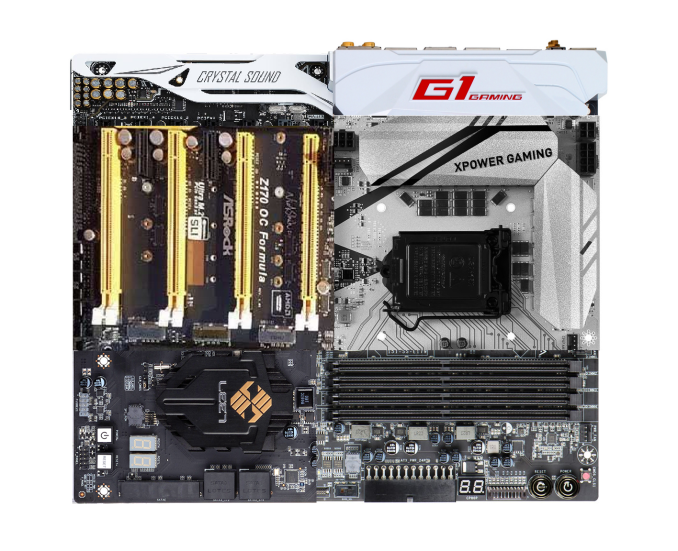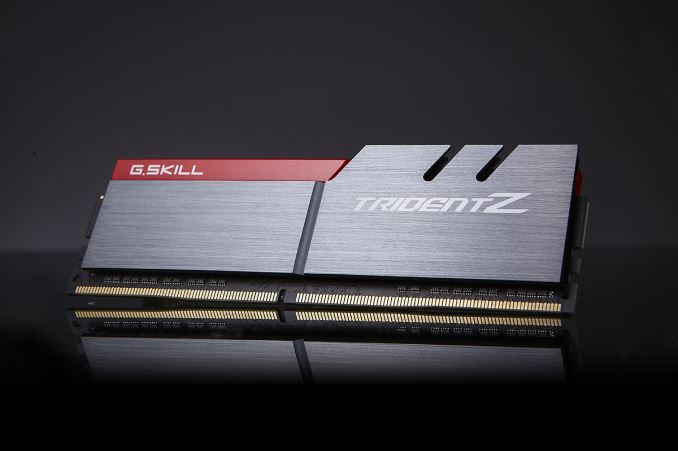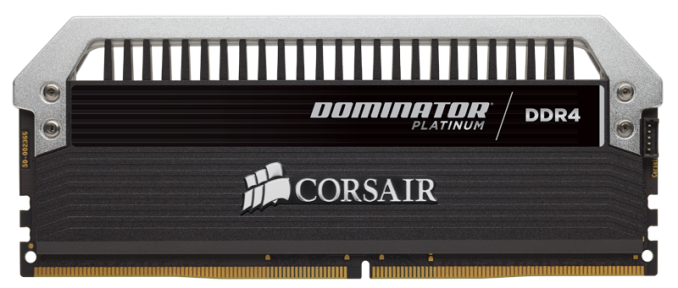The Intel 6th Gen Skylake Review: Core i7-6700K and i5-6600K Tested
by Ian Cutress on August 5, 2015 8:00 AM ESTAlso Launching Today: Z170 Motherboards, Dual Channel DDR4 Kits
The new Skylake processors are assigned a new socket – LGA1151. Intel’s policy since 2006 has been to maintain sockets for two generations and as a result moving from Broadwell to Skylake we were expecting the change. This means that Skylake processors will not work in LGA1150 based motherboards, i.e. those with Intel’s 8th and 9th generation chipsets. For Skylake we get the 100-series chipsets with additional functionality. Launching today in turn is the first member of the 100-series family, the overclocking-friendly Z170, with the other chipsets in the family to follow later in the year.
We have a large piece on the motherboards being released or talked about for Skylake, covering some 55+ products and the different variations within. The major motherboard manufacturers such as ASUS, GIGABYTE, ASRock, MSI, EVGA and a couple of others should all have a wide range ready to purchase on day one, although some models may be region specific.

The badly MSPaint’ed hybrid: MSI’s XPower Gaming Socket, GIGABYTE’s G1 Gaming IO panel, EVGA’s DRAM slots, ECS’s chipset, ASRock’s PCIe arrangement and ASUS’ Deluxe audio.
Here’s an amalgamation of some of the designs coming to end users, with almost all of them investing heavily in gaming brands with specific components to aid the user experience while gaming. Aesthetic designs are also going to be a focus of this generation, with some of the manufacturers moving into a different direction with their designs and trying some new color schemes. Some basic looking models will also be available.
Prices for Z170 motherboards will range from $80 all the way past $400+, depending on feature set and size. A number of motherboards above $150 will feature a couple USB 3.1 Gen 2 (10Gbps) ports, although you will have to check whether they are Type-A or Type-C. That being said, most motherboards with USB 3.1 will use both, but there are a select few that are C-only or A-only. Also over $150 we will see a lot of Intel’s new network controller, the I219-V, although the gaming lines might invest in Rivet Network’s Killer solution instead.
Intel is launching the Alpine Ridge controller at this time as well, which is said to support USB 3.1 Gen 2, Thunderbolt 3, HDMI 2.0, DisplayPort, and DockPort. According to our sources it would seem that GIGABYTE currently has an exclusive on this technology, and it will be used for their USB 3.1 Gen 2 ports on most motherboard models. Other functionality from the Alpine Ridge controller (TB3, HDMI 2.0) will be on a case-by-case basis depending on how the controller works in two different modes or if extra components are used. We are told that Alpine Ridge costs similarly to the ASMedia ASM1142 controller, but will enable two USB 3.1 Gen 2 ports at 10 Gbps simultaneously as it uses four PCIe lanes from the chipset.
We will go more into the 100-series chipset in the next page, but it is worth mentioning briefly here that the speed between the CPU and the chipset has increased from DMI 2.0 (5 GT/s, 2GB/sec) to DMI 3.0 (8 GT/s, 3.93GB/sec), and that the chipset has a new high speed hub (HSIO) that allows 26 lanes to be used from it although some lanes are limited (e.g. 20 PCIe 3.0 lanes maximum split into five x4 controllers). Intel’s Rapid Storage Technology is upgraded as well to give three PCIe drives access to its features as long as they are on the correct HSIO ports.
DRAM: The March to DDR4
In the world of DRAM for personal computers, DDR3 is currently king. Having been the main standard since 2007, you would be hard pressed to find a mainstream or low end platform sold that did not require access to DDR3. That changed in the enthusiast segment last year with the launch of Haswell-E which also introduced DDR4 at a high premium. For Haswell-E there was no crossover – you had no choice but to use DDR4 (unless you might be a million-unit customer).
Because the consumers and consumer product OEMs are more price sensitive, DDR4 will be a slower transition. There is precedent here in that the move from DDR2 to DDR3 saw a generation of processors that supported both standards and it was up to the motherboard manufacturer to design for it. In this transition, Skylake processors will support both DDR3L and DDR4 modules, with a few caveats.
Caveat number one is that initially, only DDR4 motherboards will be on the market. So if you upgrade now, DDR4 needs to be on the shopping list as well. We have had word of some DDR3L-only motherboards coming, as well as combo boards with DDR3L and DDR4 slots on board. Caveat one-point-five, you can use either DDR3L or DDR4, but not both at the same time.
Caveat number two, DDR3L is different to DDR3 as it operates at a lower voltage. This means that the memory controllers on Skylake most likely have a combined voltage domain, and regular DDR3 might not work (in fact early testing suggests not without reducing the voltage). Very few people currently own DDR3L DIMMs, so the likelihood of a user performing an upgrade while reusing their RAM might be slim.
Caveat number three: prices of DDR4 have dropped significantly since last year, and there is only a small premium over DDR3. The benefits of DDR4 include a lower operating voltage, a more stable design, and the ability to purchase 16GB modules with ease. That means that a Skylake platform will happily take 64GB of memory.
With that last point, we should point out that Skylake is a dual memory channel architecture, supporting two memory modules per channel. This gives a maximum of four DDR4 tests, and 4x16 = 64GB maximum.
We have been told that Skylake’s memory controller, compared to previous generations, is absolutely golden at higher speed memory support. By default Skylake supports the JEDEC standard for DDR4, 2133 MT/s at a latency of 15-15-15, but the overclocking guides we have received suggests that all processors should be able to reach DDR4-3200 relatively comfortably, with a few processors in the right motherboards going for DDR4-4000. While this should bode well for integrated graphics users, those high end kits are typically very expensive.
We currently have dual channel kits in to test from a number of the DRAM companies, and plan on performing a memory scaling article within the next few weeks to see how exactly performance might scale on Skylake. Though in the meantime, as part of this review, we were able to source a closed beta variant of a combination DDR3L/DDR4 motherboard for Skylake and have included a test comparing the two.












477 Comments
View All Comments
halcyon - Thursday, August 6, 2015 - link
Remember the time, when you could OC 50% or even 100% higher frequency on your CPU?Or the time, when every single c. 1.6 year cycle would bring you at least 50% performance increase?
Those times are over.
I'm still running 4-core(8HT)/tri-channel/SATA3/USB3 platform from 2009.
I see very little reason to upgrade, other than tinkering and spending time.
The money is burning in my hand. Intel is refusing to come out with something that is really worthwhile.
Ah well, maybe Skylake-E or maybe Cannonlake-E, or maybe...
I've been waiting to upgrade for a long time (and have upgraded my GPU several times, as there at least I get some bang for my buck).
Bambooz - Friday, August 7, 2015 - link
I remember my Core 2 Duo E4300 (1.8GHz) that ran at 3.2GHz (400MHz FSB *8) for most of it's life till I replaced it with a Core 2 Quad Q6600 (2.4GHz) that ran at 3.6GHz (400MHz FSB *9). Those were the days when OCing was actually a fun thing to do.. till intel fucked everyone over by making you pay for CPUs that can be OCed or not have any meaningful OC at all.watzupken - Thursday, August 6, 2015 - link
Come to think of it, the comparison of the i7 processor actually put Skylake i7 6700K in an unfavorable position. Honestly, I am more keen to get a Broadwell i7 5775C if I am looking to upgrade. The significantly better graphics, lower TDP and L4 cache seems like a better deal to me. Clockspeed is no big deal since the i7 5775C is overclocking unlocked if I am not mistaken.I think Intel just messed themselves up by launching the desktop variant of Broadwell with Crystal lake graphics just ahead of Skylake.
yhselp - Thursday, August 6, 2015 - link
Thank you for the review. You place a lot of emphasis on gaming and overclocking, value for money, upgrading from SB, and rightly so; however, there are no gaming benchmarks with an overclocked Skylake CPU to illustrate that point -- it would be particularly interesting to see how an i5-6600K@4.5Ghz (assuming it can reach that) fares as that would be most representative of this market.All that Sandy Bridge gamers see now is a 0.9fps to 5.8fps (excluding GRID) improvement which can't possibly justify the price of a new CPU, motherboard and memory.
MiSt77 - Thursday, August 6, 2015 - link
I would like to argue, that it's a little bit too early for the the authors' assertion, that Skylake only gives meagre performance improvements over Broadwell (and earlier processors).Considering that Skylake does in fact feature one big, if not ground breaking, improvement in that (with AVX-512) programmers now have thirty-two¹ 512-bit registers at their disposal, I think Skylake-optimized software should - at least for algorithms amenable to SIMD optimizations - be able to deliver considerable performance improvements.
In this regard it would be interesting to know, if any of the tested software already comes with proper AVX-512 support (or not, as I suppose) - regrettably, there is not even a single mention of this in the benchmark section ...
¹ That is, twice as many as before, which also should help optimizing compilers, as it reduces register pressure.
SuperVeloce - Thursday, August 6, 2015 - link
Um, no. As far as we know, only xeons will get avx-512 enabled.MiSt77 - Thursday, August 6, 2015 - link
Thank you for this factual correction!To my dismay I have to admit that you are right: AVX-512 will only be offered on (some?) Xeon models. As I'm one of those, who where waiting for Skylake specifically because of AVX-512, I find this very disappointing: thanks for ruining my day, Intel.
On the other hand, with the E3-1535M v5 and E3-1505M v5 two (mobile) Xeons were announced recently; maybe my dream of an (AVX-512 enabled) notebook can still become a reality ...
Da W - Thursday, August 6, 2015 - link
Yeee! I'll be able to keep my i7 4770k for at least a decade without upgrading!Time to spend that money on a surface pro 4, a new phone, hololens, whatever else, but my desktop will remain usable!!
Big change from the 90s :)
TheGame21x - Thursday, August 6, 2015 - link
My Core i5 2500k is still chugging along nicely at 4.2 GHz so I think this'll be another generation I'll be skipping. The cost of buying a new motherboard and RAM alongside the new CPU is a bit more than I'm willing to spend as of now given the performance increase.sweeper765 - Thursday, August 6, 2015 - link
Another Sandy Bridge owner here (2500k @ 4.6GHz 1.27v load).I've been waiting for a worthwhile upgrade. This is close but i'm not yet convinced.
The ipc improvements and new instructions are attractive but there are some negative points too:
- hotter, always hotter. Why no temperature analysis ? I see from other reviews temps in the high 80's with water cooling setups. Is this was passes as normal these days?
- need to buy DDR4 besides cpu and motherboard. I see there is a strong push towards this, despite having no real benefit relative to DDR3 (same bandwidth at the same frequency). Basically it's a kind of high frequency DDR3L. Please don't say it saves power, it's only a few watts less than ddr3 at best.
- why is stock voltage so high for 14nm technology? It's higher than my oc voltage on a 32nm 4 years old cpu. Power consumption in load is also pretty high.
- i was hoping for avx3
- cannot install win7 from usb are you kidding me? I don't have an optical drive and was doing fine without it for years now
- price goes up from generation to generation. 2600k launched at 317$, 6700k at 350$
- connectivity wise i would have liked to see more usb on back panel and more internal sata , especially with sata express consuming 2 standard ports.